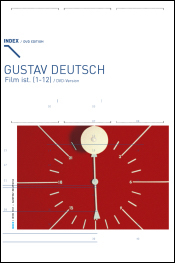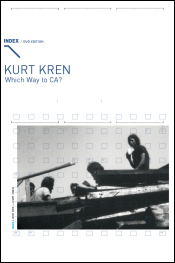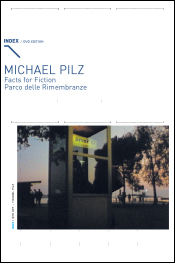GME DVD Distribution – Gustav Deutsch & Ernst Schmidt Jr., Now Available for Institutional Sales
/GME is pleased to present the release of two publications from INDEX DVD, GUSTAV DEUTSCH: NOT HOME. PICTURING THE FOREIGN FILMS 1990-2015 and ERNST SCHMIDT JR.: VIENNAFILM 1896 - 1976 (WIENFILM 1896-1976). These new editions complement GME’s previous distribution of an array of films and videos by experimental filmmakers from Austria.
◊
NOT HOME. PICTURING THE FOREIGN FILMS 1990-2015 charts the development of Austrian artist Gustav Deutsch’s signature style, displaying his talents both as a cinematographer and archivist. This collection of 3 of his lesser-known films (ADRIA, EYEWITNESSES TO FOREIGN COUNTRIES, and NOTES AND SKETCHES 1), now available for the first time on DVD, complements an appreciation of his most famous found footage moving image work, FILM IST.
"Over the past half-century, two tendencies have dominated independent, artisanal filmmaking. One of these is the fascination with the material artifacts of cinema´s history: it is often called ‘found-footage filmmaking’ and sometimes ‘recycled cinema’. Filmmakers working in this vein are often archeologists of cinema, aesthetically and/or ideologically engaging with the work of earlier generations of filmmakers of all kinds. The other tendency has produced a remarkable cinema of Place: depictions of a wide range of environments that ask us to really see (and hear) where we and our human colleagues across the globe are in relation to our natural/cultural environments. Throughout his long career, Gustav Deutsch has been an important contributor to both these tendencies."
– Scott MacDonald
In ADRIA (1990), Deutsch assembled the home movies of families visiting the Adriatic resorts during the period 1954-1968 when it became economically possible for them to document their vacations on 8mm film. Deutsch analyzes what the anonymous traveler considers memorable and discovers remarkable regularities, an optical recidivism when it comes to filming architecture, family and leisure time. Deutsch organizes the shots in ADRIA into four thematic sections. By assembling comparable sequences from these private films (e.g., frontal or side-window scenes shot from a moving vehicle, the play of waves, or the view of the coast), he makes it clear how much of our daily media consumption is based on a standard repertoire of subconsciously acquired images and points of views that indicate a collective cultural achievement on account of their normality and calculability.
EYEWITNESSES TO FOREIGN COUNTRIES (1993) was made with Moroccan director Mostafa Tabbou, comprising 600 shots that last 3 seconds each, organized into motifs in duration from 30 to 60 seconds. Deutsch filmed in Figuig, Morocco, and Tabbou in Vienna. “Many aspects of life in Morocco have parallels in Vienna, with Deutsch capturing the way in which the North African climate influences the pace of life without descending into Orientalist cliché, and Tabbou giving an intriguing insight into how Austria looks to him: ordered, bureaucratic and cold, both emotionally and physically.” (Juliet Jacques).
Deutsch’s most recent major work, NOTES AND SKETCHES 1 (2005-2015) consists of a series of ‘pocket films’ made across Europe and North America with a Canon camera and a mobile phone. Comprised of shots of varying length, the entire work lasts one hour in total. Deutsch uses digital technology to revisit the methods of the 19th century cinematic pioneers, especially the Lumière brothers. One particularly revealing location scene in Los Angeles includes shots of filmmakers and scholars Ernie Gehr, Tom Gunning and Ken Jacobs – all of whom have paid ample homage to early cinema in their written and filmed oeuvres.
Capping off Deutsch’s global cinema journeys, in SAT., 29TH OF JUNE/ARCTIC CIRCLE (1990) the filmmaker manipulates a found footage film comprising two married couples traveling from Vienna to the Arctic Circle and back.
◊
"If I had to name a single Austrian filmmaker who to this day has not received the international recognition he deserves for the artistic level his work attended, I would unhesitatingly name Ernst Schmidt Jr. When he died in 1988 at the early age of 50, Ernst Schmidt Jr. left behind a body of work that could hardly be more multifaceted… Up until the early 1970s, Schmidt Jr. realized expanded cinema Actions, created conceptual films, shot several lettrist text films, and began work on his wonderful WIENFILM 1896-1976, a two hour documentary Schmidt Jr. called 'a kind of anthology about Vienna, from the discovery of film up until the present time'.' The list of participants reads like a who's who of the avant-garde and underground scene in Austria of its day."
– Peter Tscherkassky
◊◊◊
2016 IL CINEMA RITROVATO DVD JURY AWARD
Personal choice of Alexander Horwath
"in honor of all the poets who practice an anarchist historiography"
◊◊◊
"The aim is to break down the usual clichéd "image of Vienna" such as that found in the traditional "Vienna Film" by juxtaposing documentary footage, newly shot material and subjective sequences created by various artists. Individual, self-contained sections of the film gain new meaning within the context of historical material. Familiar sites appear estranged when edited together with historical scenes. Other scenes appear like a persiflage or satirical. The film does not incorporate any commentary whatsoever. It is a collage of diverse materials aimed at conveying a distanced image of Vienna to the viewer."
– Ernst Schmidt Jr.









